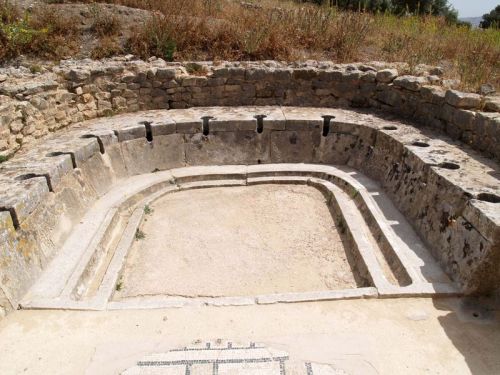ancientpeoples:Roman Bathroom HabitsThe Romans were not shy when it came to doing their “business”.
ancientpeoples:Roman Bathroom HabitsThe Romans were not shy when it came to doing their “business”. Something that we today regard as an act that demands a certain level of privacy, in ancient Rome, bathroom habits were much more open and, to a great extent, totally lacking in privacy. In a city of over one-million people, ninety-five percent of them did not have access to a private bathroom. Only wealthy Romans could afford the luxury of having a private bathroom by tapping directly into the public aqueducts, which brought running water into their homes. However, for the majority of Romans lacking their own bathroom, there were two options available.The first option was to go in any ordinary pot that you kept in your home or place of business; moreover, in the city of Rome itself, large urinal pots stood at several street corners. These “piss pots” actually had a very significant role in everyday life. The pots were collected by fullers because the urine functioned as an ancient form of bleach. Stale urine, known as wash, was a source of ammonium salts and assisted in cleansing and whitening cloth; urine made your whites white! In addition, tanners soaked animal skins in urine in order to remove hair fibers before tanning. Oddly enough these pots were eventually taxed by the emperor Vespasian which resulted in the piss pots being nicknamed after him. Flying waste was also a very common problem in Ancient Rome. Ancient writers mention anecdotes involving citizens emptying their pots from third or fourth-story windows on to whoever was walking in the street. There were laws enacted solely for the purpose of protecting those who had been hit by flying waste, “Damages to be paid by throwers of waste into the street if the person hit was injured, no damages paid for clothing or if hit outside of daylight hours.” Nevertheless, the simplest way of disposing of your waste was to throw it into the street, because the streets of Rome were naturally angled towards the center allowing waste to roll into the gutters. Some Insulae,(multi-story apartment buildings), however, could be linked by gravity-fed pipes that led to a main cesspit. Farmers would collect “night-soil” from these cesspits in order to fertilize their fields.The second option available to the inhabitants of Rome was to head to a public bathroom. Ancient Roman public bathrooms were made out of long rows of massive stone with a hole cut into the stone every few feet. Located in front of the seating area is a channel or elongated basin where your sponge sticks are located. Sponge sticks you say, what the devil for? The Romans obviously did not use toilet paper, but used sponges soaked in water. You would grab a sponge attached to a stick and clean yourself, if you need more cleaning you could plunge the sponge stick back into the little stream and clean some more. Once you are finished with the sponge stick, you scrape the sponge against the side of the stone hole you are seated on and let it fall into the flowing water; quite a logical system reminiscent of modern day bidets. Underneath those Roman derrières flowed a system of plumbing that rivaled modern day cities like New York City. Constant running water flushes away the waste into an enormous sewage systems that runs under the streets of Rome, the Cloaca Maxima (Great Drain). This system is made possible by several aqueducts that flow into the city keeping it supplied with fresh flowing water. The Roman’s effective sewage system was not in place in order to combat the possibility of disease, but more so to combat smell; the role of impure water in causing disease seemed to be little understood by the Romans.In some ancient bathrooms there is space for one-hundred people at a time. The bathrooms are open to all genders and all ages, so imagine men, women, and children all standing or sitting, doing their business next to one another in an open space. People are discussing business or gossiping to one another while going to the bathroom. Since for most Romans privacy is a unheard of aspect of life, why would it be different in this situation? However, the public bathrooms are not only visited by the common citizen, the wealthy also frequent them. Every location in ancient Rome where large crowds gather is an opportunity for wealthy Romans to pander to their constituents. Most upper-class Romans were running for some sort of political office, so the public bathrooms were a great location for mingling with the Roman people. Therefore, if you wished to hear the local gossip, chat with a friend or stranger, or simply do your business, the public bathrooms are always a good choice. Roman bathroom habits were communal, lacking in privacy, and surprisingly efficient, and they also allowed one to say, “I had a lovely conversation with a few people while sitting on the toilet the other day.” -- source link
Tumblr Blog : ancientpeoples.tumblr.com

